Magic's head designer explains why it's getting its first new card type in years
Mark Rosewater on the big story beats, characters, and new cards in March of the Machine.
I didn't used to pay attention to the story in Magic: The Gathering. I don't need to know who Sheoldred is to play Sheoldred's Apocalypse, and unless I live the dream and get to be on nerd quiz show Um, Actually someday, I don't need even more trivia about imaginary worlds in my head.
That changed last year with The Brothers' War and a series of short stories by Miguel Lopez about a time-traveling planeswalker named Teferi who went back to a time of trench warfare with giant robots to learn about a weapon powerful enough to defeat a threat he knew he'd face in the future. Those war stories full of death and desperation got me interested in Magic's lore, and the conflict they were foreshadowing. Like Teferi, I worked my way back and forward at the same time, reading about the coming threat: biomechanical horrorshows called Phyrexians whose origins lie in Magic's early days and whose multiversal invasion is the subject of its next set, March of the Machine.
As head designer of Magic: The Gathering, you might expect Mark Rosewater to be a rules-over-story guy. His blog, Making Magic, where he explains behind-the-scenes decisions based on card-type percentages and managing mana curves, certainly tends to focus on mechanics. But he's just as passionate about plot, as his fast-talking video appearances demonstrate, and says the biggest challenge in March of the Machine was conveying the scope of its story. "I remember when I first went to the creative team to understand what the story was," he recalls, "they said, 'the Phyrexians attack the multiverse'. And I was like, 'Which worlds do they attack?' And they said, 'All of them!'"
There are plenty of cards in the set depicting places Magic's visited recently—the backdrop of Nezumi Informant is the glowing neon streets of Kamigawa, while City on Fire shows the art deco edifices of New Capenna—but a few go for what Rosewater calls "deep cut" planes. Volcanic Spite, for instance, returns to Azgol, a burning world with an angry god introduced in a 2012 card called Lair of the Ashen Idol and not seen since.
One of the cool things about making a set that occurs on all planes of the multiverse is you're free to do whatever characters you want.
Mark Rosewater
Rosewater explains they decided which of Magic's many planes to include by putting them into "three buckets". In the first went planes that had a set dedicated to them in the last 20 years, in the second went anything referenced often enough people knew it by name, and the third held deep cuts like volcanic Azgol, or prehistoric Muraganda. "We did all of bucket one, most of bucket two, and a handful from bucket three," he says. "Most of the more obscure worlds came down to which ones fit the color options we were trying to fill."

These worlds from all across the multiverse are accompanied by a selection of characters just as diverse, some of them paired in Odd Couple match-ups like monster-slayer Thalia riding giant amphibious beast The Gitrog Monster, to illustrate the unlikely alliances the Phyrexian threat makes possible. "When we first pitched them in vision design, we combined creatures from different worlds," Rosewater says, "but creative explained that wasn't how the story was working. The Phyrexians are attacking each individual world, so we kept them to be characters from the same plane."
His personal favorite match-up of oddballs is either frog spirit Yargle and tree wizard Multani, or the gigantic cyclops Borborygmos with the perpetually lost homunculus Fblthp, who are united by the fact they're both one-eyed. "One of the cool things about making a set that occurs on all planes of the multiverse is you're free to do whatever characters you want," he says.
Keep up to date with the most important stories and the best deals, as picked by the PC Gamer team.
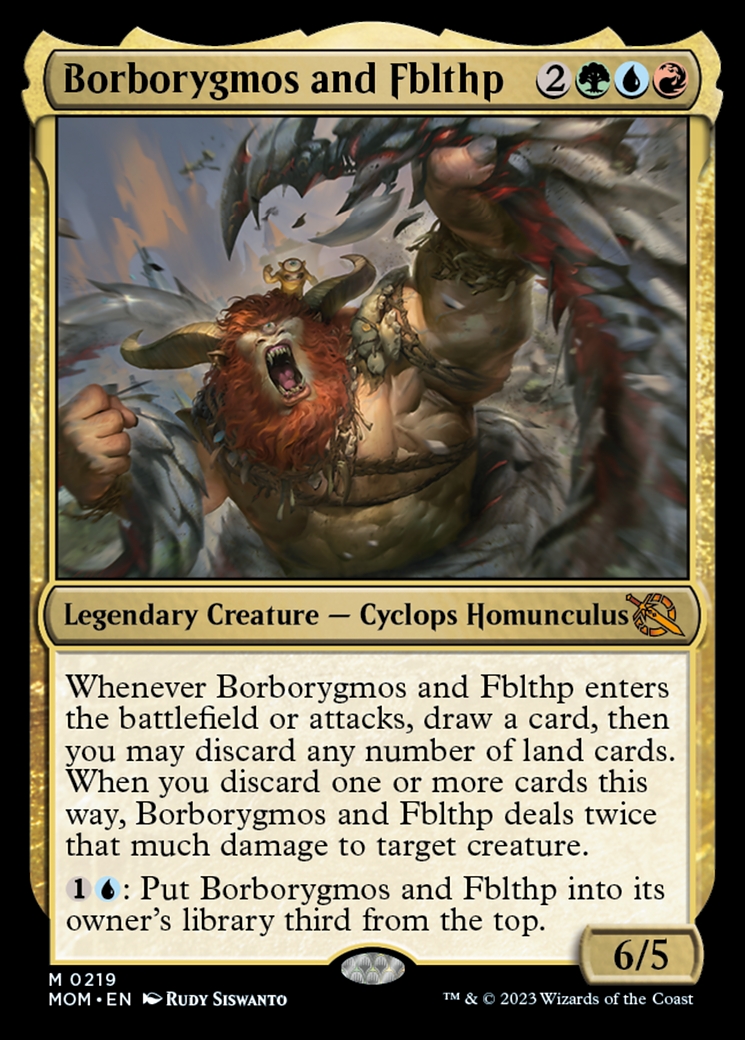

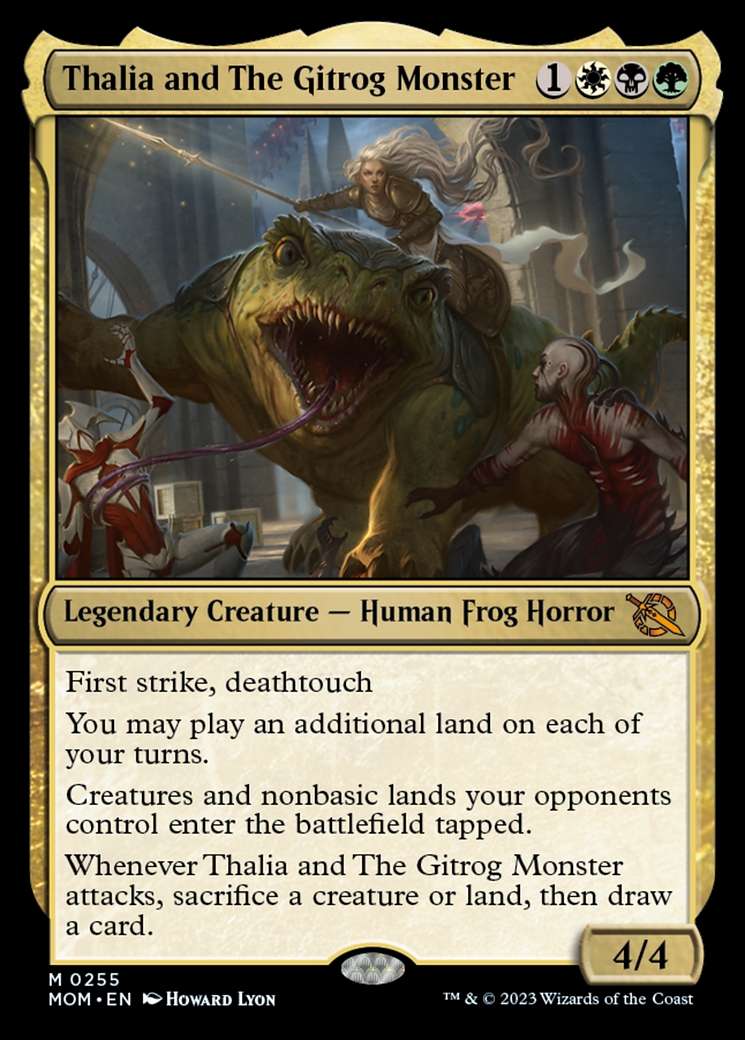
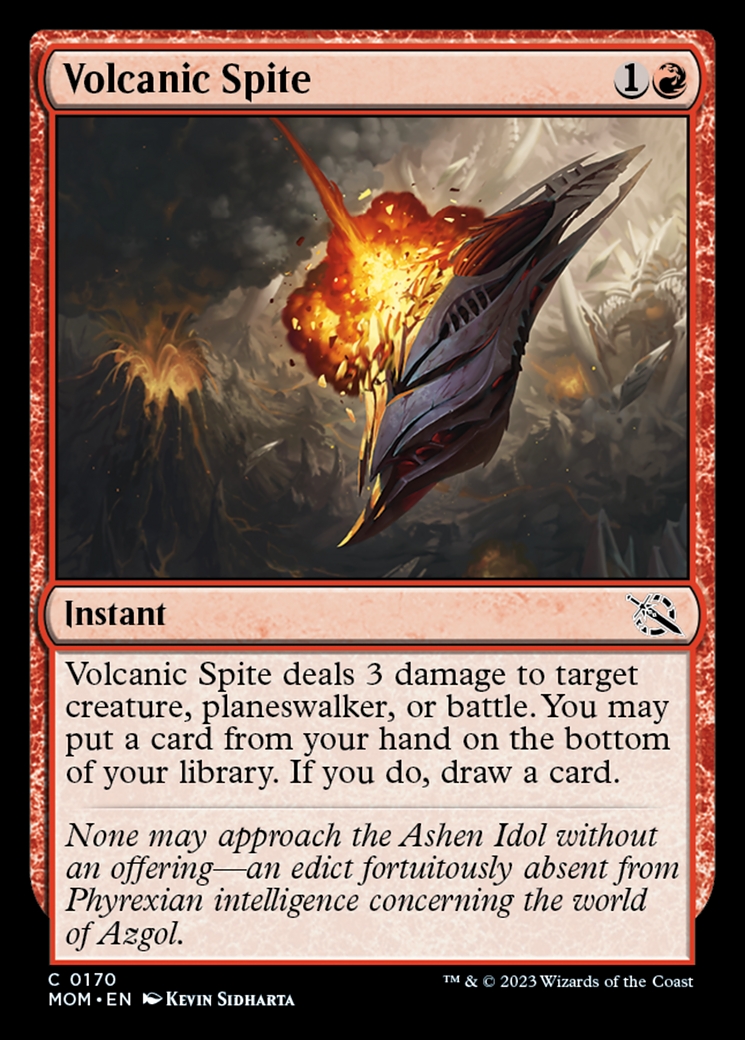
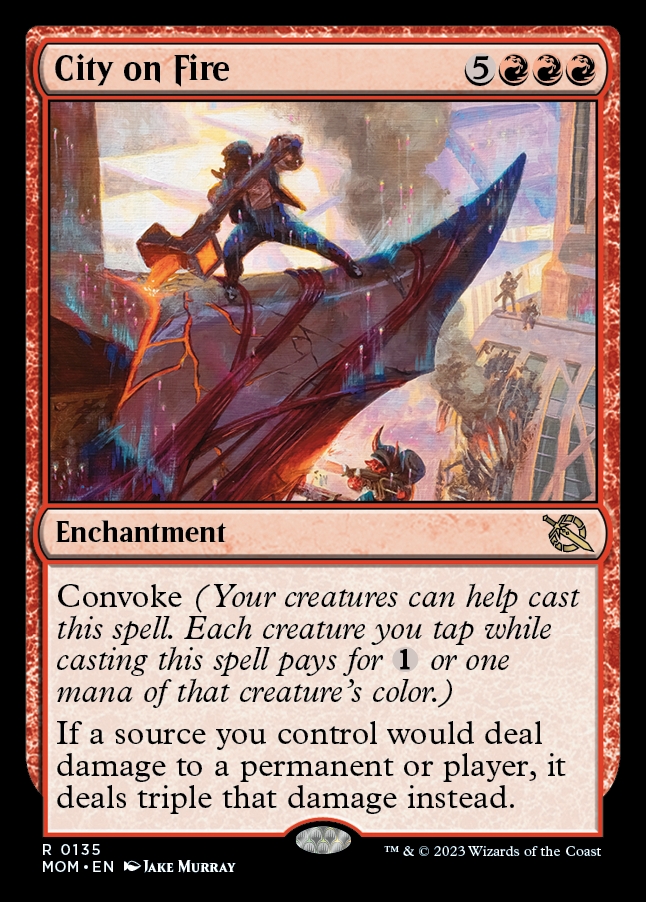

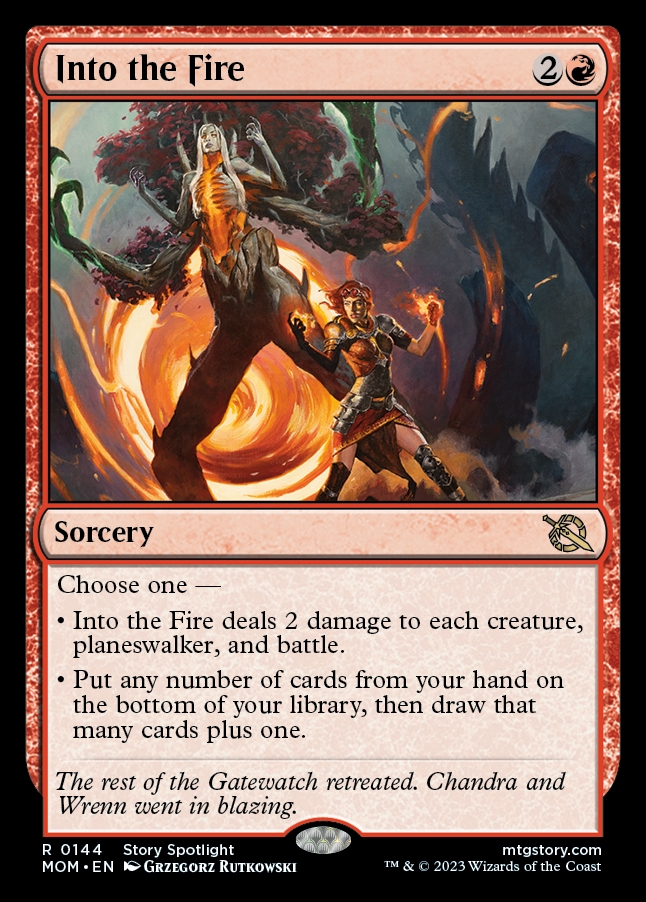
Though that aspect of March of the Machine was freeing, there were also limitations. Where a set focused on one location has space for any idea fitting the theme, a set focused on telling the climax of a saga like this has to hit all its story beats and represent them mechanically.
March of the Machine's main story writer K. Arsenault Rivera said in an interview with Hipsters of the Coast that, back when she was writing fiction for the Innistrad set, she knew its cards would emphasize the training and vow mechanics and so she put in scenes of ordinary people learning to fight monsters to represent them. She'd seen the Rural Recruit card, with a farmboy preparing for battle alongside his mean-looking pig, and wrote them in too. In March of the Machine, things were the other way round. Story came first, and the design team had to work to fit it on the cards.
"In an event set, specific things happen," Rosewater says, "and you just have to figure out how to represent it. I do think event sets end up being a bit more out there, as the restrictions, as I like to say, breed creativity. I don't think we would have made battles, for instance, if we weren't trying to capture the feel of the Phyrexians invading every known world of the multiverse."
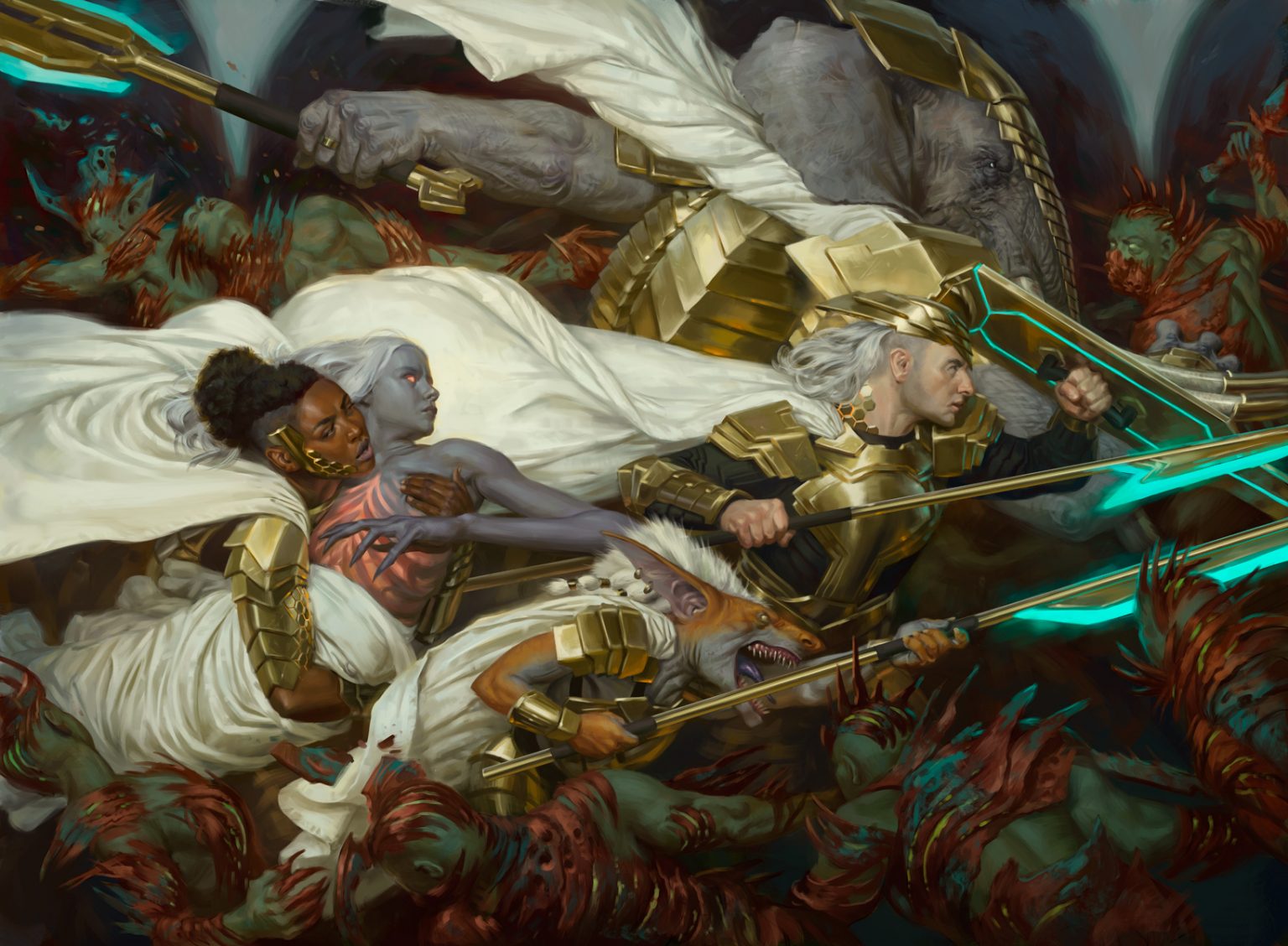
Battle master
Battles are the big feature of March of the Machine: a completely new card type. The ones we've seen so far depict sieges on one side, and are flipped when defeated to reveal a spell the battle's original owner gets to cast for free. The battle card Invasion of Innistrad, with that plane's werewolves and vampires holding out against Phyrexians on its front, flips to become Deluge of the Dead, a spell that lets you make zombies (presumably from the bodies of those who fell in the siege). Invasion of Shandalar, returning to the high-mana plane created for MicroProse's 1997 Magic videogame, becomes Leyline Surge, letting you tap that wild magic to play a free permanent at the start of your upkeep each turn.
The twist with these siege battles is that when you play one, you assign it to your opponent. Then you try to defeat it by knocking its defense counters off, while they protect it to prevent you from earning the tasty reward on the card's other side. You have to fight your own battles, get it?
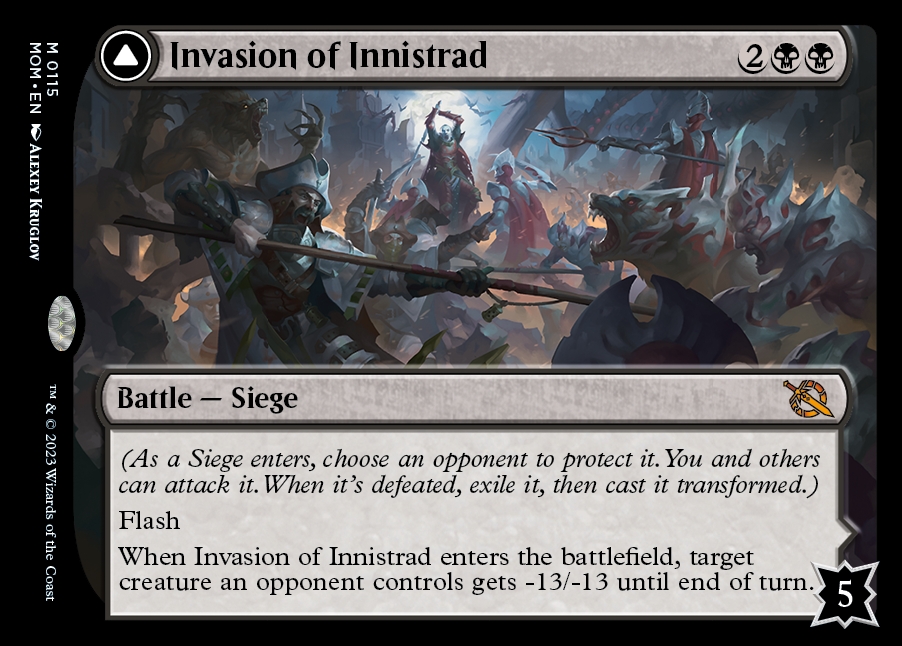
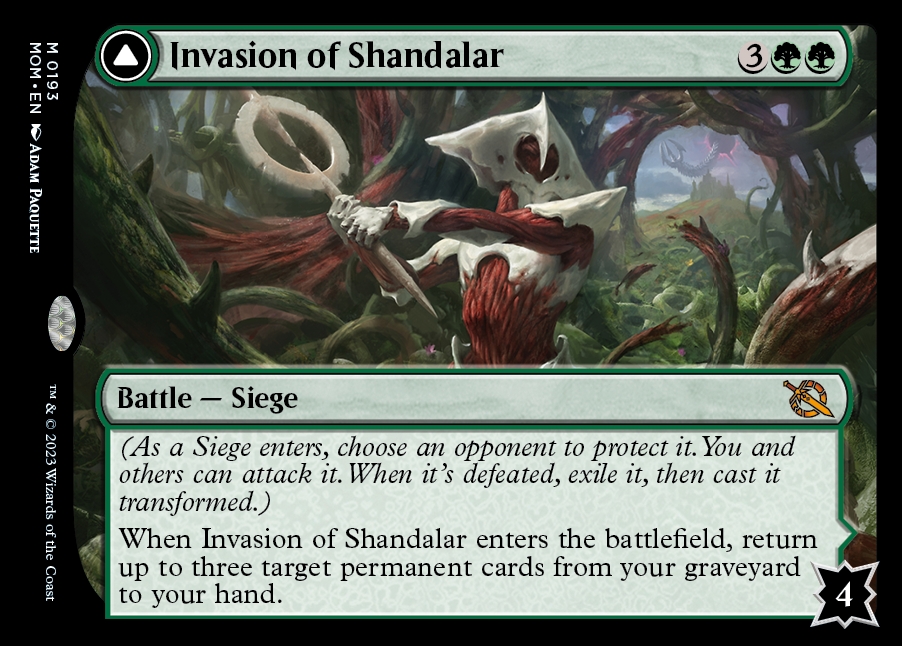
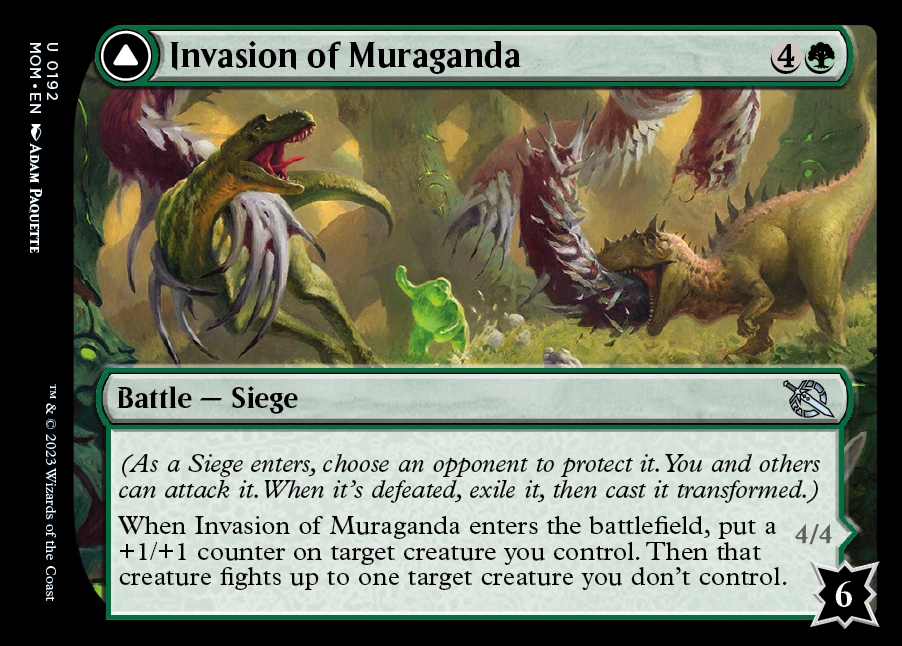
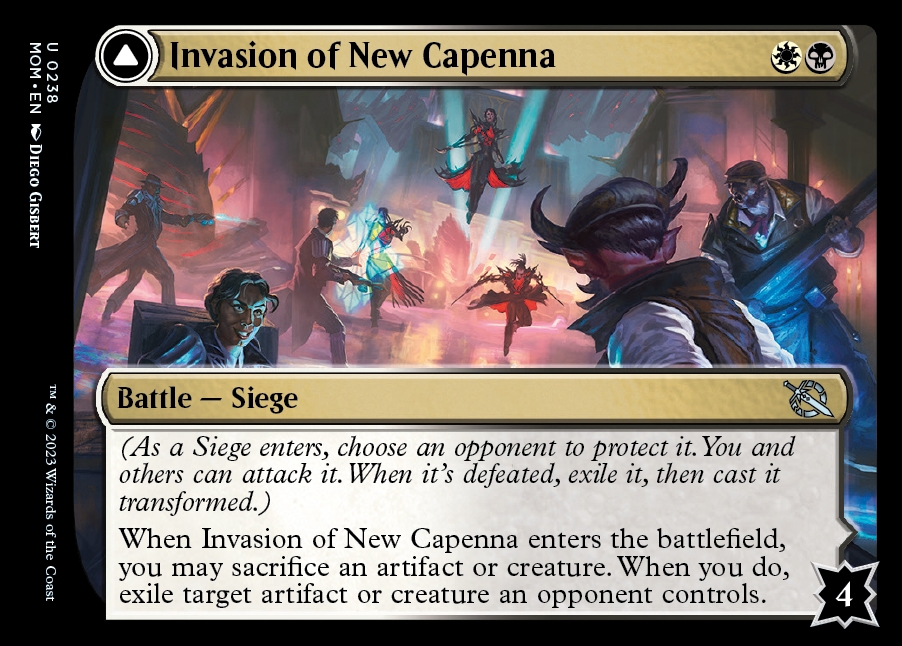
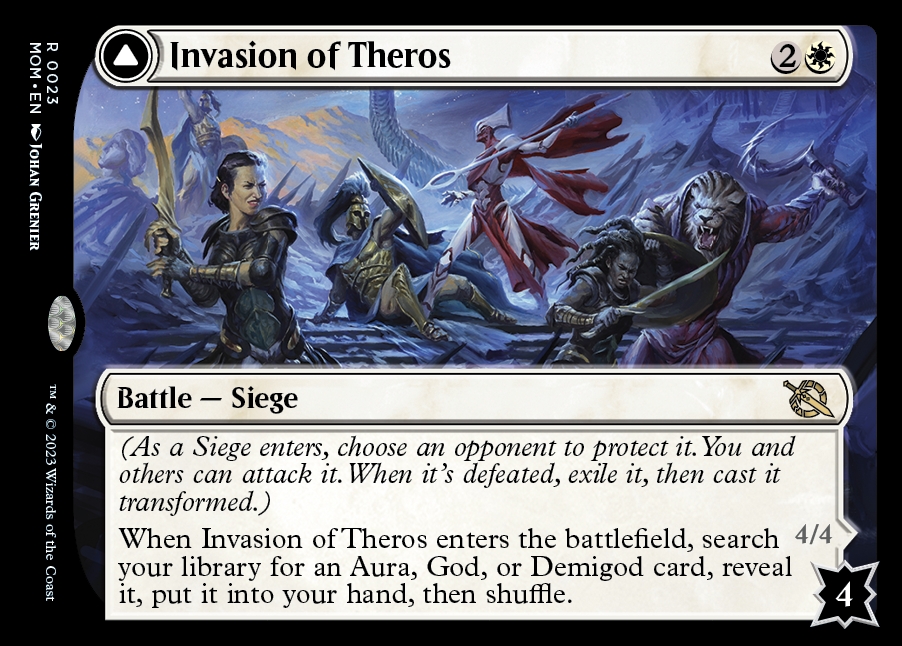


Adding a new card type isn't something that's done lightly. While the 2021 crossover set Adventures in the Forgotten Realms gave us dungeon cards, those don't go into your deck—they're more like tokens. For a new card type that gets played from the hand, we have to go back to planeswalkers, introduced in the Lorwyn set all the way back in 2007. Clearly Magic's designers don't open the glass case and press the big red "new card type" button without good reason.
"When we first started working on March of the Machine, I decided that I wanted the lens of the set to be the planes of the multiverse," Rosewater says. He wanted there to be something in every booster to represent that, but it took a while to arrive at the final version. First, the vision design team came up with the idea of land cards representing specific planes. "You would play the land, which tapped for mana, and you could pay a mana cost to transform it and 'planeswalk' to a specific plane which would generate an effect," Rosewater says. While they were double-faced and had counters on them that could be removed when they were attacked, they were otherwise quite different to battle cards as they are now.
The idea of Planechase is that there's a bigger game overlaid on top of the normal game.
Mark Rosewater
When vision design handed the idea over to set design, the latter team "had some issues with that execution," Rosewater says. "They liked the idea of planes you could attack but ended up making it something that an opponent defended, and you attacked instead of vice versa. They also came up with the idea that the prize for winning the battle was you got a card on the back face that you could cast for free. Letting you cast it allowed us to make it any card type. In the end, we had something we thought was super flavorful and played well, so we chose to hit the big red button."

The idea of planes being the lens we see March of the Machine through is also illustrated by the return of Planechase format, first introduced in 2009. March of the Machine's prebuilt Commander decks will come with 10 planar cards that form a separate deck, representing different places and magical phenomena. Whichever planar card is in play has a high-level effect, perhaps adding extra mana or creature abilities to cards. "The idea of Planechase is that there's a bigger game overlaid on top of the normal game," Rosewater says. "The magical duel is set on a particular plane and that creates mechanical abilities that all the players can use."
To move between them you roll a "planar die", with a chance to set off additional effects called "chaos ensues". The Gavony card, representing the one place on Innistrad where humans held out against the undead, gives all creatures vigilance, meaning they can defend even if they just attacked. If chaos ensues, your creatures also become indestructible. Other chaotic effects might turn creatures into food, give you an extra turn, or otherwise randomly shake things up. "It's a more casual way to play," Rosewater says, "creating more variance than the average game of Magic."

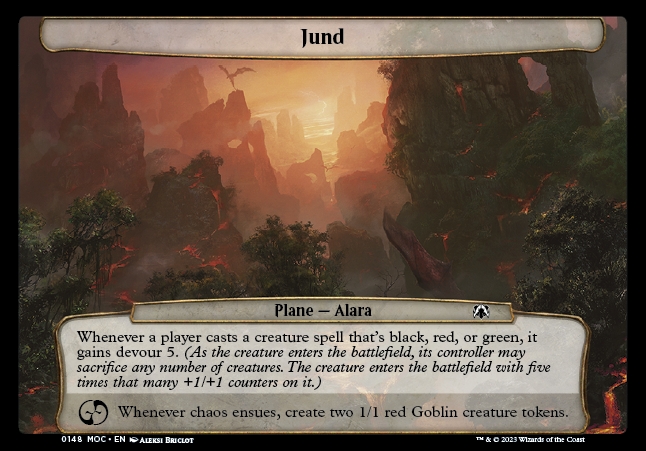

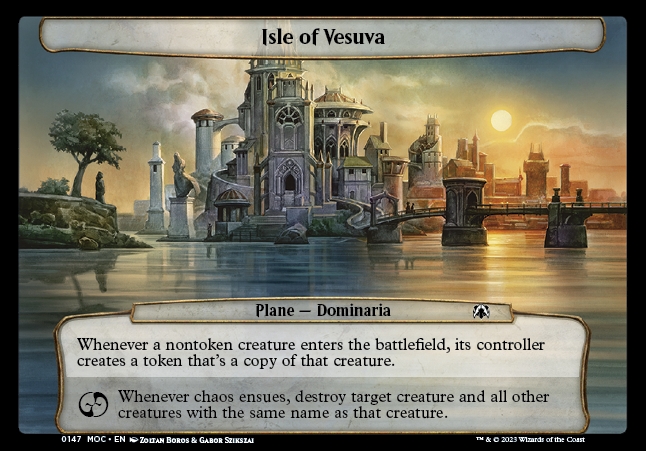
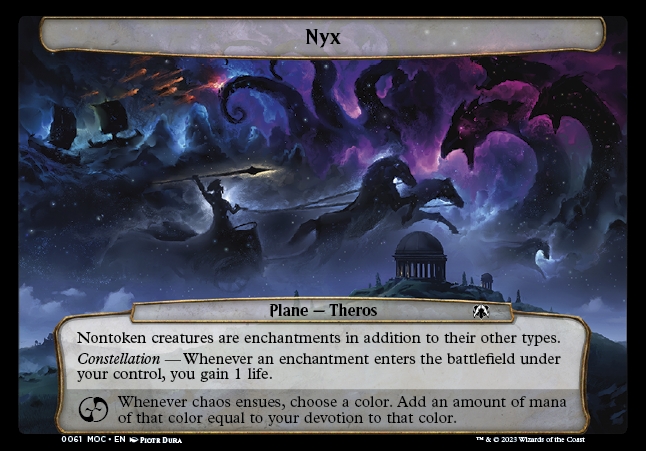

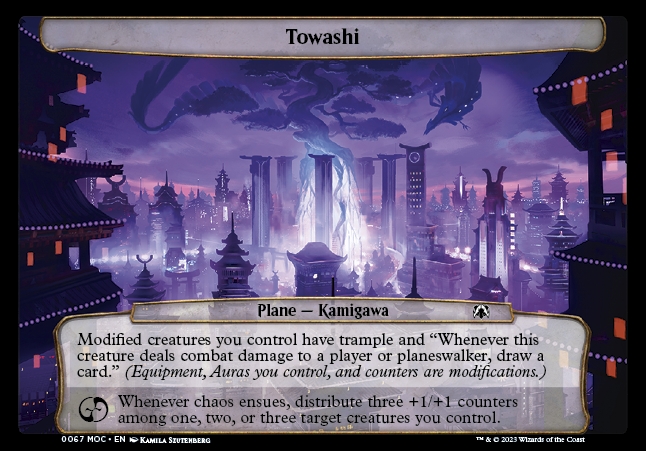
Time is on my side
The idea for March of the Machine goes back a long way, though Rosewater says how far exactly "depends when you want to start counting." We could go back 20 years to the Mirrodin set, which hinted that Mirrodin had been infiltrated by Phyrexians, last seen being defeated in the Apocalypse set two years before. "We took our time ramping this story up," he adds.
In 2010, Scars of Mirrodin followed up on those hints with the Phyrexians revealing themselves, conquering the plane, and transforming it into New Phyrexia. "The Scars of Mirrodin block story set up the Phyrexians as a dangerous villain, but they had one Achilles' heel. They couldn't travel between planes." Fast-forward to Aether Revolt in 2017, which established the existence of a Planar Bridge that could transport non-living matter. As Rosewater notes, "fans of the story recognized that the planar bridge also would have use to the Phyrexians. They are a combination of metal and flesh, and while the bridge would kill the flesh portion, it wouldn't stop the metal part."
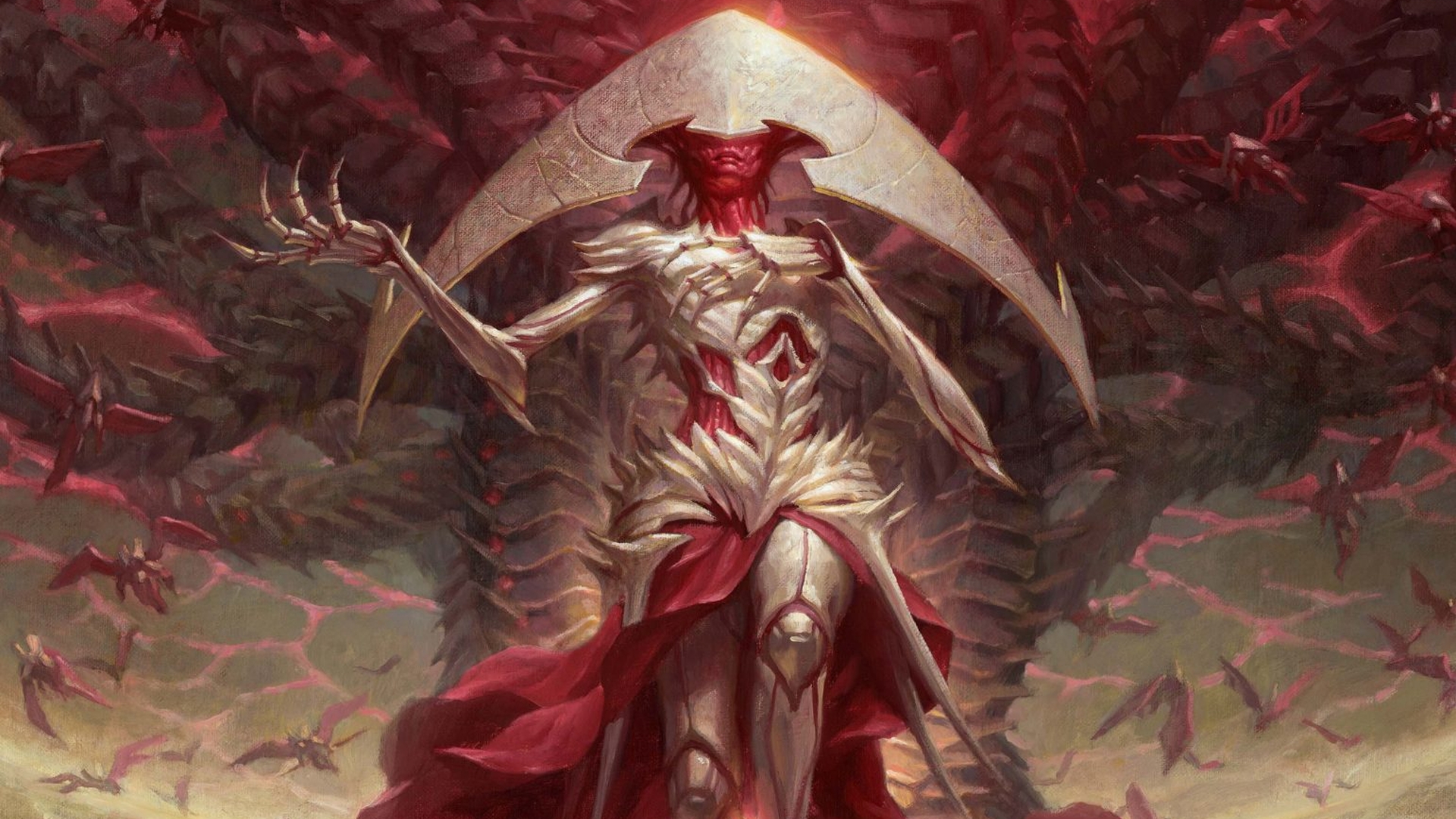
In 2021, Kaldheim detailed a plane based on Norse mythology complete with a World Tree connecting its realms, and featured a cameo by one of the Phyrexian's praetor leaders, Vorinclex, who sent his metal components through the planar bridge and regrew the fleshy bits on the other side to steal a seed of that tree the Phyrexians could corrupt into a better way of connecting worlds. Other praetors infiltrated other planes, showing up in sets over the next couple of years to keep them on players' minds.
So how long in the making has March of the Machine been altogether? After Rosewater reminds me the designers always work on sets two years' in advance, he puts it at, "Twenty-two years if you start at original Mirrodin. Fifteen years if you start at Scars of Mirrodin. Four years if you start at Kaldheim. No matter which you choose, quite a while."
March of the Machine arrives in Magic: The Gathering Arena on April 18, and in paper form on April 21. A small epilogue set of 50 cards called March of the Machine: The Aftermath will follow in both digital and physical versions of Magic on May 12.

Jody's first computer was a Commodore 64, so he remembers having to use a code wheel to play Pool of Radiance. A former music journalist who interviewed everyone from Giorgio Moroder to Trent Reznor, Jody also co-hosted Australia's first radio show about videogames, Zed Games. He's written for Rock Paper Shotgun, The Big Issue, GamesRadar, Zam, Glixel, Five Out of Ten Magazine, and Playboy.com, whose cheques with the bunny logo made for fun conversations at the bank. Jody's first article for PC Gamer was about the audio of Alien Isolation, published in 2015, and since then he's written about why Silent Hill belongs on PC, why Recettear: An Item Shop's Tale is the best fantasy shopkeeper tycoon game, and how weird Lost Ark can get. Jody edited PC Gamer Indie from 2017 to 2018, and he eventually lived up to his promise to play every Warhammer videogame.

